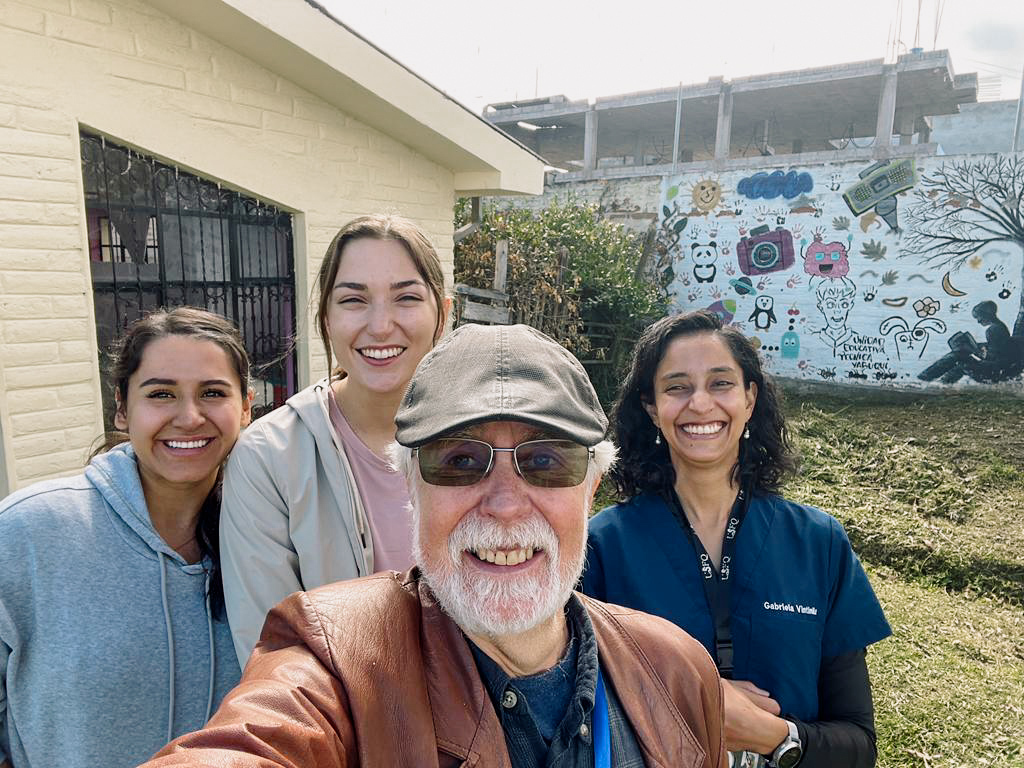Under a large tent outside a medical clinic in El Quinche, Ecuador, shiny pink streamers sway in the April breeze.
It seems like an unlikely place for a baby shower, but the women gathered here are familiar with the spot.
They first entered the tent months before as newly expectant mothers, referred by their health-care providers to register for the Mikhuna Project, a WashU-led study on maternal nutrition and infant brain formation.
First photo: Lora Iannotti (left), founder and director of the E3 Nutrition Lab and a professor at WashU’s Brown School, and researcher Shirley Tipanquiza (right) speak to expectant mothers about maternal and infant nutrition at El Quinche Clinic as part of the Mikhuna Project. Second photo: Lora Iannotti (far right) and Pamela Camana (left) hand out bags filled with fresh vegetables, fruit, eggs and fish for expectant mothers at El Quinche Clinic. Third photo: Pamela Camana (left) paints a pregnant mother’s belly during a baby shower at El Quinche Clinic. After an informational workshop on maternal and infant nutrition, Mikhuna Project researchers held a baby shower for participants.
The participants returned to the tent throughout their pregnancies to pick up food, learn about nutrition and receive medical exams. On this day, they gather to celebrate some of the babies soon to arrive — infants whose brain scans may help countless more children in the future.
25%
of young children in Ecuador experience stunted growth
40%
of Indigenous children in Ecuador are stunted
150m
children globally are stunted
Here in Ecuador, 25% of young children experience stunted growth, usually due to malnutrition. Among the country’s Indigenous children, the number jumps to 40%. Globally, nearly 150 million children are stunted. Participants in the Mikhuna Project and their babies are contributing valuable data that may help reduce these troubling statistics.
Lora Iannotti, founder and director of the E3 Nutrition Lab and a professor at WashU’s Brown School, has been combatting childhood malnutrition and stunted growth for decades. Her research projects in Haiti, Ecuador, Kenya and Madagascar have focused primarily on a child’s critical first 1,000 days of life.
“The consequences of being undernourished in that period can be irreparable,” Iannotti says. “If nutrition is compromised by poor-quality diet, infectious disease or otherwise during the first 1,000 days of life, children will likely never reach their full genetic potential.”
Stunting is defined by a child’s height-for-age relative to growth standards set by the World Health Organization (WHO), but the effects go far beyond physical stature. Stunted growth can lead to issues with cognition and school performance. It’s associated with lower productivity and wages later in life and may even result in intergenerational impacts.
“What’s exciting about Mikhuna is that it introduces measures of the brain that are often hard to capture at the community level. It’s … [an] understudied area.”
Lora Iannotti
With funding from the Children’s Discovery Institute, a partnership between St. Louis Children’s Hospital and WashU Medicine, Iannotti and collaborators at the Universidad San Francisco de Quito (USFQ) in Ecuador are testing the effects of an intervention that aims to reset the starting clock. The researchers want to see how tackling malnutrition before a child is born, starting with a pregnant woman’s diet, shapes growth. And rather than relying on proxy measures like height, they seek to directly understand how maternal diet affects infant brains.
“What’s exciting about Mikhuna is that it introduces measures of the brain that are often hard to capture at the community level,” Iannotti says. “It’s a fascinating and understudied area.”
Hidden hunger in the highlands
The Mikhuna Project takes place in a peri-urban area outside Quito, Ecuador’s capital. The project’s home base, the small city of El Quinche, has food markets, businesses and a Catholic shrine that attracts hundreds of thousands of pilgrims per year.
Above photo: Clouds roll over the Andes Mountains as Iglesia y Santuario de la Virgen de El Quinche is illuminated at dusk in El Quinche, Ecuador. The city is located an hour northeast of Quito.
At first glance, El Quinche may not seem like a hot spot for chronic malnutrition. But as in many areas of the world, including the United States, some residents experience what researchers call “hidden hunger.”
Children need calories to grow, but they also need several critical nutrients. Hidden hunger arises when diets lack limiting nutrients such as iron, zinc, iodine, and vitamins A and B12 — nutrients that are also crucial for brain development. It can happen when a family eats mostly a single food, like rice, or overconsumes ultra-processed foods. Often, poverty and the cost of healthy foods play a role.
In an earlier pilot study, Iannotti and the Mikhuna Project’s co-principal investigator, Iván Palacios, MD, evaluated the specific dietary problems found near Quito. In addition to commonly missing micronutrients like zinc and choline, maternal diets lacked high-quality proteins and omega-3 fatty acids that usually come from eating fish or other animal-source foods. The pervasive presence of convenient and affordable processed food also contributed to a high rate of pregnant women who were overweight or obese.

Mikhuna’s co-principal investigator, Iván Palacios, MD (right), and Lora Iannotti present preliminary results to participants in El Quinche, Ecuador.
As a public health specialist at USFQ, Palacios had deep knowledge of the local health-care system. He led the selection of research sites and arranged approval and logistics with the national Ministry of Health, which runs health clinics for lower-income families. After years of study design and planning, the Mikhuna Project was underway.

A sustainable, evolutionary dietary pattern
With referrals from the state-run health clinics, the Mikhuna Project recruited 200 lower-income pregnant women on a rolling basis over the course of more than a year.
Mercy Vásquez, a study participant, takes a break from cooking dinner to feed her then 16-month-old son, Liam, in their apartment.
Half of the women received a basket of food to bring home every week during their second and third trimesters, as well as targeted messaging about healthy eating. The other 100 women received standard prenatal care, messaging for other health outcomes and social support from the Mikhuna team. At a handful of intervals throughout their pregnancies, all participants gave blood and had ultrasounds conducted to measure fetal growth, brain development and other parameters such as placenta volume.
Maternal nutrition studies in low-resource settings often rely on supplements or fortified foods, Iannotti says. In this project, she wanted instead to test whether adding sustainably grown, “evolutionarily appropriate” foods — fish, eggs, fruits and vegetables — to a pregnant woman’s diet would measurably improve fetal growth.

Lora Iannotti and her team fill bags with fresh vegetables, fruit, eggs and fish delivered by Amazonic Gardens for expectant mothers at El Quinche Clinic.
“This project was a fundamental pillar for me during my pregnancy.”
Mercy Vásquez
Providing real food rather than supplements benefited the participating mothers as well. “The basket was very useful, very practical,” says Mercy Vásquez, one of the project’s first participants. “I was able to easily cook with it for the day. And I could stretch it for a week because they would give us enough food.” Vásquez’s son, Liam, is now a healthy toddler, and she traces his love of strawberries to all the fruit she ate during pregnancy. “This project was a fundamental pillar for me during my pregnancy,” she says.
The idea of evolutionarily appropriate food has long been a core value of Iannotti’s work. (Alongside “environmentally sustainable” and “equitably accessed,” it’s one of the three Es in the E3 Nutrition Lab’s name.) The term points to foods that humans ate for 99.5% of our hominin history, most of which happened long before the existence of processed foods and even before the emergence of agriculture.
Tens of thousands of years ago, humans had larger brains and longer lifespans than in some later eras. They likely consumed a diverse diet that included animal sources like fish and other marine life. Hypothesizing that a return to some of those trends might result in better childhood growth, the Mikhuna Project selected food for both overall diversity and specific nutrients. (Evolutionary appropriate food doesn’t equate with fad-driven “paleo” or “primal” diets, Iannotti notes.)

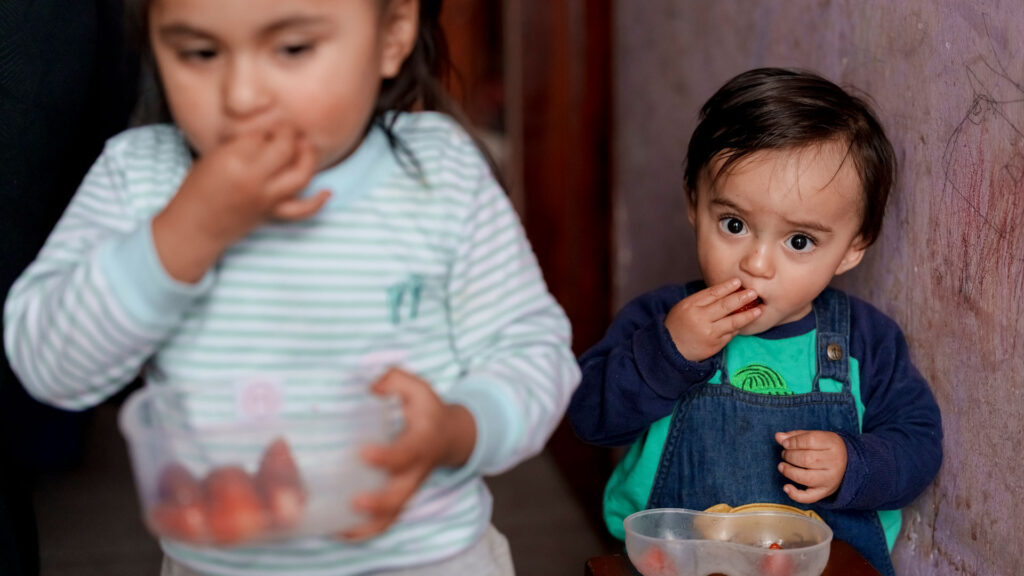
For the group of women receiving food, each weekly pickup included two fish and eight eggs, along with fruits and vegetables. The produce varied from week to week and included foods like locally grown naranjilla, gooseberry, blackberries, kale and spinach.
To source the food, Iannotti and the Mikhuna field team, led by USFQ’s Gabriela Vintimilla, MD, worked with owner Karen Ballarades of Amazonic Gardens, a local supplier. Her wholesale garden grows native fruits and vegetables and harvests trout from spring-fed ponds.
Every week, Vintimilla orchestrated schedules with those receiving food. She and her team carefully documented the contents and nutrients of each delivery, and they asked participants to share what they had eaten the week before.
Some unexpected struggles arose. “We had civil unrest that lasted almost three weeks, at which point we couldn’t travel to the clinics to take data,” Vintimilla says. “We managed to move deliveries to Saturday, when the strikes were less intense, but we lost a window of three weeks for the recruitment part. So after that, we included a new clinic to have more participants.”
In another case, a flood interrupted trout delivery, and the researchers pivoted to providing tilapia. They also made changes to accommodate personal needs, like the food aversions that often come with pregnancy.
“We’re testing a dietary pattern. Malnutrition is usually not about a single food.”
Lora Iannotti
“Because I saw the moms every single week, they were able to tell me, ‘I really can’t have more trout,’” Vintimilla says. “So we tried to look for solutions, like giving them tuna or sardines — things that they would eat instead of the usual fish.”
The research team always documented these types of changes, but by design, the challenges didn’t diminish the study’s overall effectiveness. Diversity of food was always part of the plan.
“We’re testing a dietary pattern,” Iannotti says. “Malnutrition is usually not about a single food. While my other trials have looked at eggs or fish separately, in this case, it was a whole pattern — one that we hope extends into the future, too.”

A window into the growing brain
Many parents recognize the thrill of the 21-week ultrasound, sometimes called the anatomy scan, when providers measure a fetus’s growth. Mikhuna participants experienced these scans at both 21 and 35 weeks.
Paul Silva Hidalgo (left) performs an ultrasound on an infant’s brain as Lora Iannotti (right) looks on with the mother at El Quinche Clinic.
In addition to typical ultrasound data like body length and head circumference, the WashU researchers, in collaboration with Jennifer Nicholas, MD, a pediatric radiologist at Cincinnati Children’s, sought to gather hyper-specific brain measurements like the volume of the gangliothalamic ovoid (the combined area of two brain parts, the basal ganglia and the thalamus), biparietal and cerebellar diameters, and the length of corpus callosum. A few weeks after the child’s birth, a final ultrasound examined the newborn directly.
These measurements were possible thanks to infants’ natural development. The two soft spots in a newborn’s skull, called the fontanelles, provided the researchers a window into the growing brain. Skilled ultrasound technicians can peer through this soft tissue in a way that’s not possible in the toddler stage going forward, once the fontanelles have hardened.


Using ultrasound has other advantages. Compared with large and expensive MRI machines, ultrasound is very “field friendly,” Iannotti says. For a trained radiologist, it’s relatively easy to perform on both pregnant women and newborns.
In addition to the brain scans, the Mikhuna researchers conducted a neurological exam called the Hammersmith on all the babies. The Hammersmith captures information about reflexes, muscle tone and more. It’s one way to start piecing together the dots between nutrition, brain morphology and behavior.
“By using the ultrasound and measuring parts of the brain, we’re looking at what I would consider to be the biological mechanism, or the pathway. But what we really care about is the child’s actual functional development,” Iannotti says.
“When the newborn comes back to the clinic for the first time, there’s a whole battery of tests for those different domains of development. Those measures tend to be ‘noisy’ and hard to capture. But I want to be very clear: We’re not stopping at the point we say ‘this part of the brain is bigger than that part.’ We want to know: Did learning and memory improve? Did motor development improve?”
The power of partnership
On paper, the Mikhuna Project is a randomized research study. In practice, it’s a wide web of partnerships and trust connecting Iannotti, the USFQ research team, Ecuador’s Ministry of Health, undergraduate and graduate students, WashU research collaborators and, perhaps most importantly, the mothers in the study.
Mikhuna’s research team presents preliminary results to participating mothers in El Quinche, Ecuador.
Vintimilla’s local team hosted the baby shower in April, along with several more throughout the project. They set up a WhatsApp chat for the moms to build ongoing friendships. They organized regular workshops, and the mothers chose what they wanted to learn about. When participants expressed interest in self-esteem and self-care during pregnancy, for example, Vintimilla found someone in the USFQ psychology department to lead a session.
The parties and workshops provided a service to the mothers, including the 50% who did not receive weekly food baskets but still chose to participate for the duration of their pregnancies. They also were important for keeping the trial running smoothly.
“The moms who didn’t go to workshops were more likely to drop out of the project,” Vintimilla says. “But with the moms with whom we created a connection, they were always willing to continue. For them, it was not a matter of being in the intervention group or control group. Creating that community was key to keeping participants in the study.”
Erika Viana, one of the participating mothers, found Mikhuna to be “a beautiful experience” as she navigated a high-risk pregnancy. With two daughters already at home and few friends or extended relatives living nearby, she turned to her fellow participants for connection and understanding.

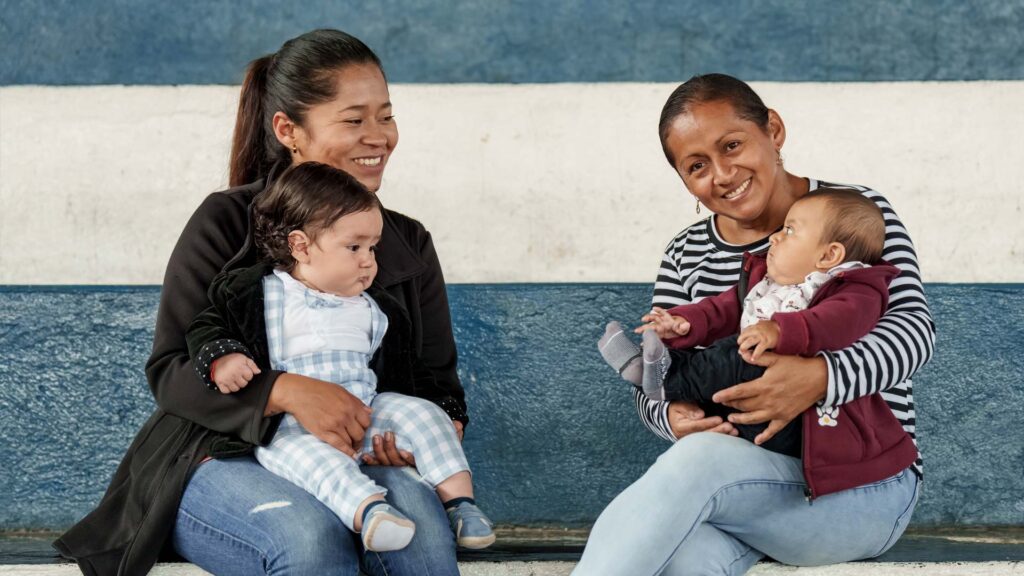
“They understood how I was feeling, something that others outside didn’t,” Viana says. “Every time I went there, I released all my stress from the situation and all the bad things the doctors would say about the pregnancy. I would go there, release all the negativity, and come back home feeling renewed. Going there was like therapy for me.”
Mercy Vásquez, the participant whose son is now a toddler, calls Mikhuna “a life-giving project.” “I learned that there are many supportive people who think about others, who help other people,” she says. “They looked for ways to help us during a time when we were in a vulnerable state. I send many hugs from Ecuador to the people who made this project possible and helped me with my nutrition during pregnancy and with my baby.”
This type of intentional relationship-building doesn’t happen in all studies, Vintimilla says. “Most research is based on numbers and data, but tends to leave the people out,” she says. “Mikhuna is different. We did create a connection between each participant and the team.”

In her kitchen, Mikhuna participant Erika Viana cooks food for her daughter, Seleny Geovana.
Rachel Zimmerman, MPH ’24, credits the success of these community-building efforts to the local field team in Ecuador. Now the WashU-based project coordinator for Mikhuna, Zimmerman started working on the project as a graduate student. She connects regularly with the USFQ team and spent three months in Ecuador for the project last year, focusing mainly on data management. She believes that having teams embedded in the community is essential in public health research.
“As a lab, we focus on having teams that are local, who understand the people we work with, who can build trust, and who are going to be there long term,” Zimmerman says. “Working with the USFQ team has been fruitful and encouraging. They’re very meticulous but also very caring toward all the participants we have in our study.”

Beyond the data
As in all of her work, Iannotti hopes the information gathered in the Mikhuna Project will inform health-care practice and lead to real-world benefits for children.
Erika Viana carries her daughter, Seleny Geovana, as she collects eggs from her backyard chickens.
From the start of the project, she and Palacios intentionally partnered with the Ministry of Health in Ecuador, the agency ultimately responsible for policy change.
“We are working with a couple of clinics that belong to the Ministry of Health,” says Palacios, who serves as the project’s primary government liaison. “They are helping us to advance on the study, and we are sharing the methodology of intervention with them and discussing the findings of the study. This is a very team-based and participatory approach.”

Lora Iannotti (right) tours Amazonic Gardens organic farm with owner Karen Ballardes in Baeza, Ecuador.
“Through years of research, we’ve learned it’s really important to involve the policymakers early on,” Iannotti says. One of her earlier randomized trials, the Lulun Project, proves the point.
In Lulun, Iannotti’s team introduced eggs to babies during the complementary feeding period — the months when infants begin shifting from breast milk to solid foods. Especially in low-resource settings, it’s a vulnerable moment when growth can falter. Sometimes families aren’t quite sure what’s safe or healthy to feed their weaning babies, or they don’t have access to healthy foods.
In Ecuador and around the world, Iannotti found that nutrient-rich, low-cost eggs can be a lifeline. By giving babies one egg per day starting at 6 months old, earlier than previously recommended, Lulun reduced stunting in the intervention group by a staggering 47%. The infants’ blood also contained higher concentrations of choline and docosahexaenoic acid (DHA), which are important for brain development.
As a direct result of Lulun, the Ministry of Health in Ecuador changed its national recommendations on when to introduce eggs to babies. The partnership worked.
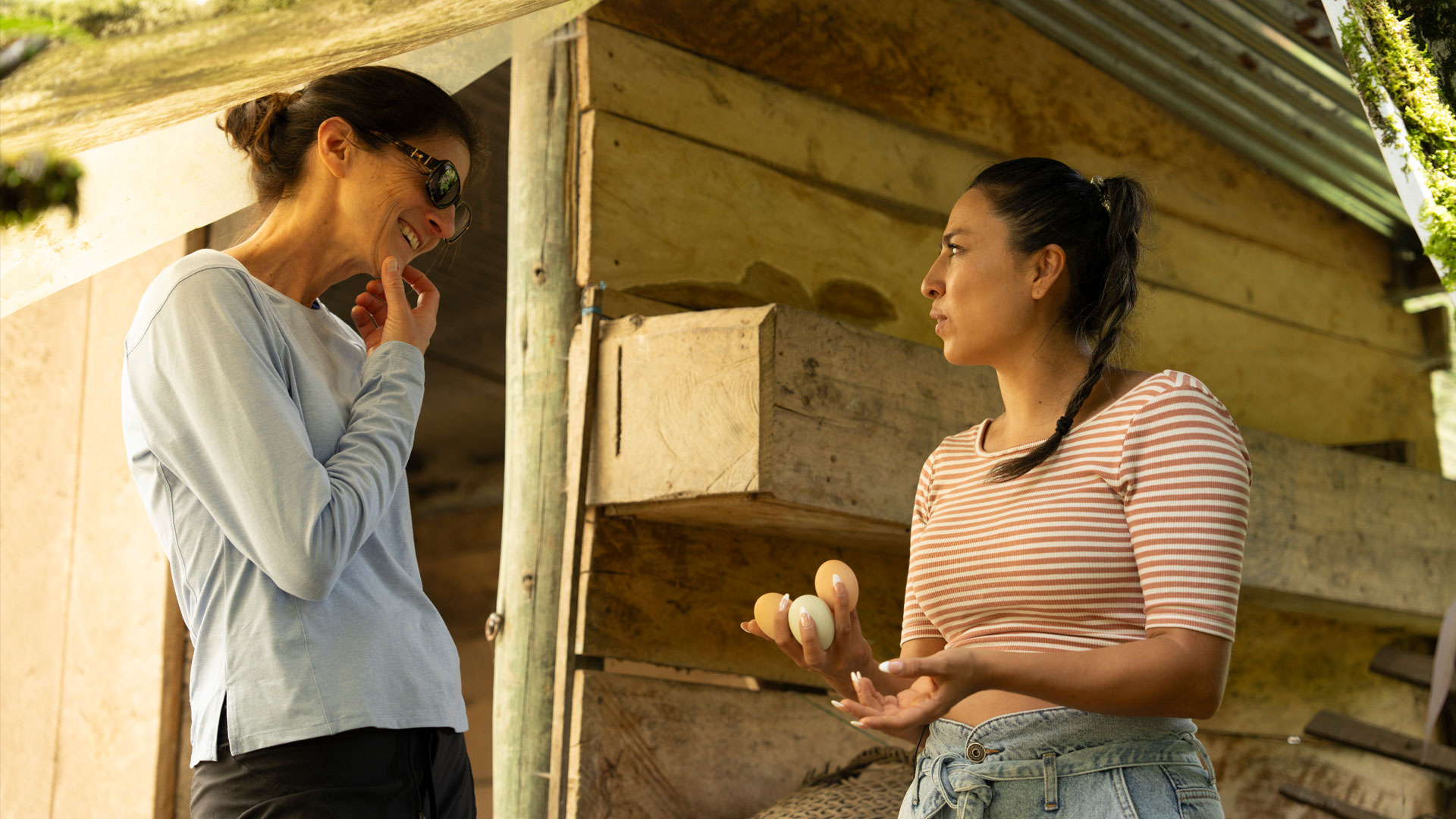
Lora Iannotti (left) discusses eggs as she tours Amazonic Gardens organic farm with owner Karen Ballardes in Baeza, Ecuador.
Iannotti and her collaborators spent this summer and fall organizing and cleaning up data collected from the hundreds of ultrasounds, blood tests and physical exams conducted in the field. They’ve been working meticulously, ensuring the anonymity of the intervention and control groups as long as possible. Once thorough analysis is completed in 2025, the team is hopeful that the Ministry of Health will follow the data to consider changes to dietary recommendations, as it did with Lulun. The researchers also point to other potential policies that might make a difference in infant health and growth, beginning in Ecuador but potentially around the world.
“If the results are important in terms of the comparison group, we will probably use them to advocate for policy changes to ensure access to animal protein, especially for women who live in rural and Indigenous communities,” Palacios says.
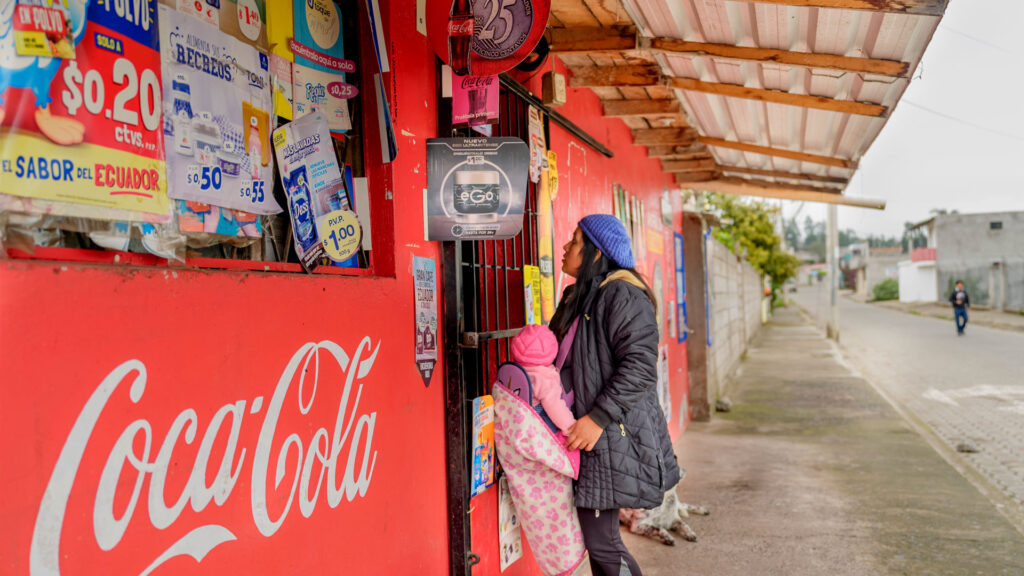

Ensuring access means addressing affordability, as inequity and malnutrition go hand in hand. “The idea in Mikhuna was to introduce food that you could find everywhere here in the market and that is easily accessible,” Vintimilla explains. “But when we did focus groups with the moms, they told us that, yes, they can buy it, but they cannot afford it.”
“In public health, context means everything,” Iannotti says. It’s a grounding belief that she will continue to champion in her lab’s many projects around the globe, as well as in her public health leadership roles at WashU. In 2023, Iannotti became the first director for planetary health and environmental justice at WashU’s new Center for the Environment. As the previous associate dean for public health at the Brown School, she also played a major role in the planning of WashU’s soon-to-launch School of Public Health.
“Public health is fundamental to human well-being, and it’s also fascinating as a field of study in its connections to other disciplines and schools already at WashU,” Iannotti says. “If this isn’t the moment for public health, then what is?”
